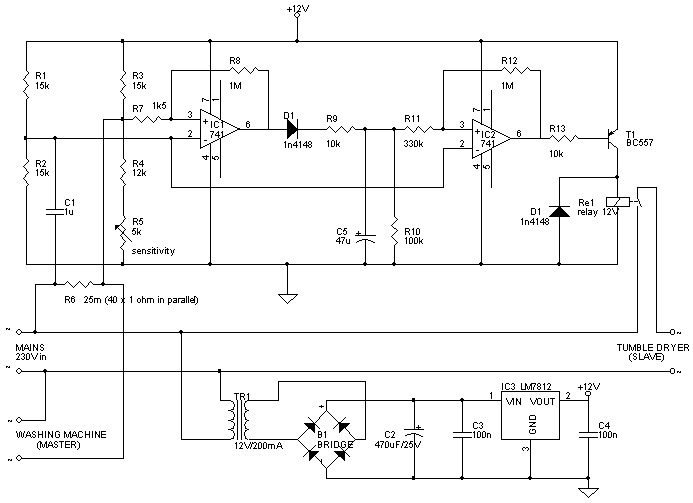 -Wash & Tumble-
-Wash & Tumble- 
 -Wash & Tumble-
-Wash & Tumble- 
-Your washing machine & tumble dryer on one wall outlet-
Introduction
This circuit enables you to connect both your washing machine and your tumble dryer on one
wall outlet,
without blowing the fuse!
The trick is that the washing machine only consumes full power when heating the water.
During the other stages (pumping, tumbling, centrifuging) the power consumption is much
lower.
The circuit switches off the tumble dryer during the (brief) time that the washing machine
is heating the water.
I designed & built this circuit years before I started my web site, it has been in use
ever since, but I forgot about it!
Certainly a reliable design....
Because it has proved its reliability, I just copied the old circuit diagram without any
changes.
Circuit description
The current of the washing machine if fed through 25 milliohm shunt resistor R6.
R6 is built with 40 x 0.25W standard resistors of 1 ohm.
Note that the dissipation in R6 is quite high at 16 Ampere: 16x16x25milliohm=6.4 Watt or
160 mW per resistor.
For 120 V application, the maximum current will be even higher; you will need even more
resistors in parallel for R6!
R1 & R2 create a reference voltage of half the supply voltage.
When the AC signal across R6 is high enough, it will trigger the schmitt trigger built
with IC1, R7 & R8.
The sensitivity can be adjusted with R5, I used 4 100W lightbulbs as load to set my
circuit on about 400 Watts.
When IC1 is triggered, a 50 Hz square wave will appear on output pin 6. C5 will be charged
fast through R9 and D1.
When C5 is charged, the schmitt trigger built with IC2 is triggered and its output (pin 6
) will become high.
When the output of IC2 is high, the relay will switch off the tumble dryer.
D1 protects T1 against high voltage peaks from the coil of relay Re1 when it is switched
off.
Wash & tumble schematic:

Circuit application
When the circuit is assembled, the sensitivity can be adjusted with R5.
When you plug in the mains, both the washing machine and dryer output should have mains
voltage.
When you connect a load to the washing machine output, the dryer output will be switched
off at a certain load.
I set my circuit on 400 Watts by connecting 4 100W light bulbs on the washing machine
output and then turn R5 until the relay just switches off the dryer output.
The proper setting depends on your washing machine; the 400 W setting worked ok for me,
but this is just an indication. The dryer should not be switched off very often.
→ Download specifications of key components at the Component specs page